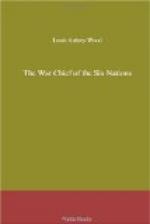Not long after the rout of the Six Nations on the Chemung river and the destruction of their villages the snow had begun to fall. The winter of 1779-80 was an unusually severe one, and the Indians suffered untold hardships through famine and disease. They were driven to trek in great numbers to the vicinity of the English fort at Niagara. Brant was there at this time, and during his sojourn he saw a wedding performed according to the sacred rites of the Anglican Church. He had lost his first wife, the mother of Isaac and Christiana, and had married her half-sister, Susanna; but she also had died childless, and Brant had taken to his tent the daughter of a Mohawk chief, whom he now decided to wed after the manner of the white people. His third bride, who was about twenty-one years of age at the time of her marriage, is known in history as Catherine Brant. She bore Brant three sons and four daughters, and lived for some years after his death. Her father was the leading sachem of the Tortoise clan and consequently she was able to bestow high rank within the Mohawk nation upon her son, Ahyouwaighs, or John Brant.
The story of Brant’s part in the War of the Revolution from this time on can be related very briefly. Before spring he was again on the war-path and helped to destroy the villages of the Oneidas, because of their active sympathy for the rebel cause. In the month of April he closed in upon the settlement of Harpersfield and levelled it to the ground. As he was making his way back from the last adventure, he was seized with fever and forced to move by slow stages. He allowed his warriors to travel only every other day. There is an anecdote telling how he cured himself of his malady in a very Indian-like manner. Taking his position on the side of a hill, a haunt of rattlesnakes, he waited till one should crawl out to bask in the sun. When at length a snake showed itself he seized it and bore it to his camp. This reptile was cooked in a broth, and Brant supped eagerly of the hot decoction. And after partaking of this wonderful remedy, according to the story, he was well again in a very short time.




